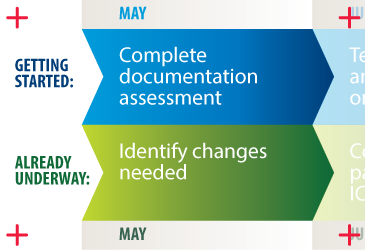Physicians have less than six months to transition to the ICD-10 code set, meaning it’s officially crunch time. Whether you’re already on the road to implementation in your practice or you need a little more guidance, use this month-by-month primer to get you ready for the Oct. 1 deadline.
Just getting started?
Spend your time in the month ahead identifying the changes you need to make in your practice for ICD-10.
For example, you’ll need to update your systems, forms and work flow processes. Pull together a group of all staff members involved in coding, billing, claims processing, revenue management and clinical documentation, then figure out each task necessary to bring your practice in line with the new code set. Ask the group members how and where they use ICD-9, and go from there.
Once you have a plan, you can more easily estimate and secure funds to update your practice management system, purchase new coding guides and send your staff to training. Use a transition checklist to get started.
Already on your way?
ICD-10 requires new levels of documentation requirements, so now’s the time to assess your current documentation practices and how they will support the new code set.
The documentation for ICD-10 coding may not be that different from your current documentation—it’s likely that the more detailed information required under ICD-10 is already in your clinical notes. For example, the ICD-10 pregnancy codes are broken down into trimesters, which will be in your documentation.
Also, keep in mind the changes in codes and increased level of detail are specific to specialties. Orthopedics has the highest increase in codes because many are simply separate codes for “right” versus “left.” This information would already be in your documentation.
Decide whether you want to perform the documentation assessment yourself or you would like to get outside expertise. There are organizations that will provide feedback on your current situation and whether it will be sufficient for ICD-10. You also can conduct your own assessment with resources, such as this tip sheet (log in) or a how-to guide from the AMA.
The AMA is urging regulators to ease the burden of ICD-10 implementation on physicians, but you should make sure your practice is prepared.
An ICD-10 data file available on CD-ROM or via immediate download is an essential resource. Additional information and resources to help physicians get ready for ICD-10 are available on the AMA ICD-10 Web page.
Editor’s note: This post is the first part of a new monthly series that will provide timely transition tips and resources as the Oct. 1 ICD-10 implementation deadline approaches.





